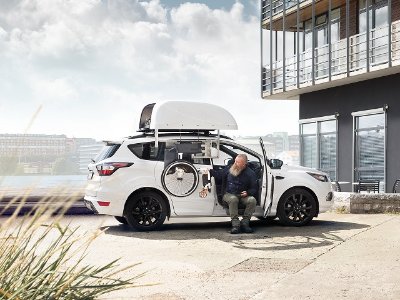
Car adaptations: The alternative to WAVs
As a disabled person or someone with limited mobility, having a vehicle that works for you is important to help you stay independent and active outside the home.
While a WAV can be the best choice for some people, especially those with more complex wheelchair needs, it may not suit everyone. This includes people who can move themselves from a wheelchair into a car seat, either on their own or with help.
Thankfully, vehicle adaptations offer a practical and accessible solution. We encourage you to look at everything available to help you travel in a way that works for your needs and your lifestyle.
Adaptations are a popular option for drivers and passengers. They can be added to many makes and models of cars, so you’ll have more choice, even including EVs and hybrids.
You might want a car with a lower Advance Payment, a smaller car to make parking easier, or one with a particular look. With adaptations, you can enjoy the comfort and features of a standard car, while also meeting your access and driving needs.
Your Scheme approved adaptation installer can help you make the right choice
What is an adaptation?
Adaptations are changes to a vehicle that make it easier to use. There are many types, so it’s best to speak to an adaptations installer for advice. Adaptations can help you drive, get in and out of your vehicle, or store equipment. Many are available at no extra cost through the Motability Scheme, as long as they’re fitted at the start of your lease.
The importance of mobility assessments
First, it’s important to have a mobility assessment with a vehicle adaptation specialist. This usually looks at three areas: getting in and out, seating and driving, and where to store your wheelchair or scooter.
You’ll be asked things like whether you can move yourself into the seat, if you use a smaller or manual wheelchair that can be taken apart, or if someone helps you with this.
Matt Fieldhouse, Mobility in Motion’s Managing Director says, “It’s imperative that you are completely honest throughout the assessment process, providing accurate information about your mobility needs, driving habits and any challenges you face. This ensures that the recommended adaptations are perfectly suited to enhance your comfort, safety and overall driving experience.”
Access and seating solutions
Vehicle access products help you move from a wheelchair into a standard driver or passenger seat.
A person hoist electronically lifts you via a fitted sling that is positioned around you while seated and operated by a handset. This means no one has to lift you themselves when helping you in or out of the car.
A transfer plate provides a stable temporary platform on the outer edge of the seat on which to pause and pivot from either standing or a wheelchair. These are available as a static solution or an electronic solution which can move up and down to the desired height.
Swivel seats take out the original car seat and add a special seat on a rotating base. This can turn out of the car, either manually or electronically, to make it easier to get in and out.
Another option is the Carony System is a fully comprehensive wheelchair transfer solution which transfers the car seat onto a wheelchair base. This seat acts as your car seat and wheelchair seat in one, for a lifting-free transfer solution.
The Carony system lets you transfer from wheelchair to car seat without lifting
These options help you:
Take full advantage of standard safety systems like locking seatbelts, airbags and supportive seats
Enjoy the usual luxuries such as air conditioning, heating and music
Sit in the front or back of the vehicle with your travelling companions for a comfortable and sociable journey
Keep your current car or choose freely when you’re looking for a new one
Wheelchair stowage
Once you’ve chosen your preferred seating option, you can look at ways to lift, store and carry your wheelchair or scooter when using your car.
A wheelchair roof box stores a manual wheelchair in a secure weatherproof box on top of the car. You can use a handset from inside the car to lift and lower the chair, so it works for drivers and passengers.
A boot hoist lifts your mobility device into the boot of the car using lifting points and a crane-style arm.
Both are helpful ways to carry your wheelchair or scooter and avoid the heavy lifting often needed to load them by hand.
Driving adaptations
Safety is the most important part of driving both for you and everyone else on the road. There are many adaptations that can help you drive safely and confidently.
If you cannot use the standard pedals, hand controls can be added to move the accelerator and brakes to a hand lever.
If you find using your right leg hard, you can have a left foot accelerator added. This goes next to the brake and can flip between right or left foot use which is handy if you share your car.
Steering aids help you steer with one hand. These are often used when you have hand controls too.
In the end, your needs will help decide whether adaptations or a WAV is the best option. Speak to your local Motability Scheme installer for expert advice based on your needs and what works for you.
source: https://news.motability.co.uk/motoring/car-adaptations-the-alternative-to-wavs/
Fill in your details below and a member of our team will be in touch
By providing your details you consent to us being able to contact you using the methods given above. Read more.

